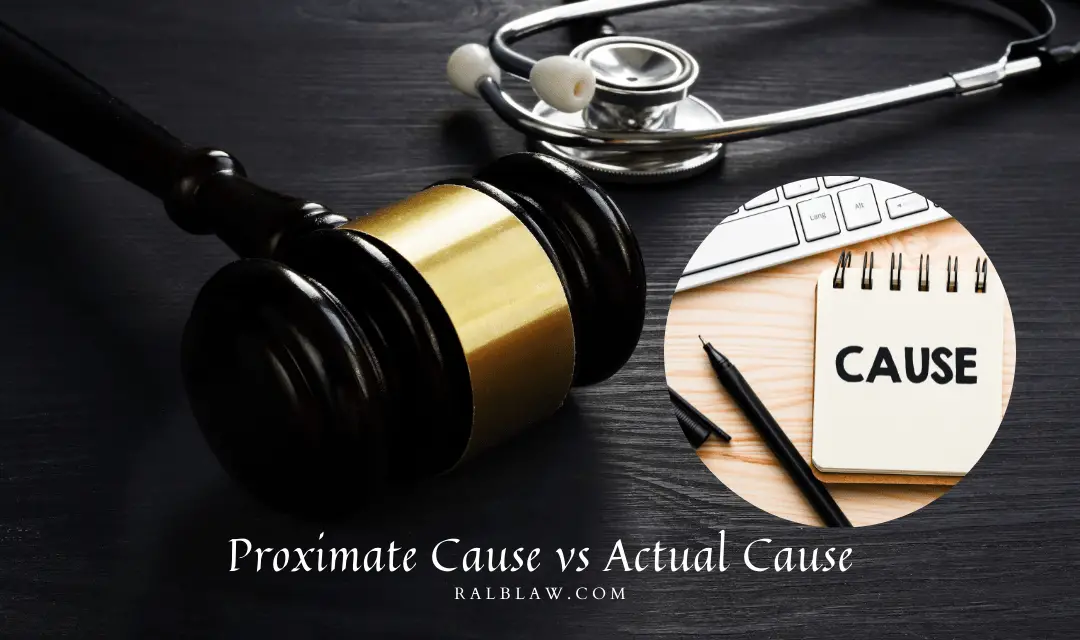As a principle in Criminal Law, proximate cause is tacitly discussed in Article 4 of Philippine Penal Code.1 Said provision of the law states that:
“Criminal liability shall be incurred by any person committing a felony (delito) although the wrongful act done be different from that which he intended.”2
What is the principle of proximate cause?
The above provision of law speaks of an act being committed, which would cause injury to another. Although, the injury resulted is not the same as what the actor had anticipated or intended.
Even though the resulting felony or crime is different from that which the perpetrator had intended, still, he shall be liable for the resulting offense and the one that he initially intended. Hence, the maxim:
“El que causa de la causa es causa del mal causado: The one who causes the cause is the cause of the evil caused.”3
For this to apply, it is indispensable that the act or the initial cause that sets in motion the series of events leading to the resulting crime must be in itself a wrongful one.
While, as said above, it is not explicitly defined in the article, proximate cause is implied therein. There are concepts of proximate cause known in criminal law. Prominent of which are:
- Error in personae
- Abberatio ictus
- Praeter intentionem
Legal Cause and Actual Cause
Proximate cause is the legal cause or one that the law recognizes as the direct, natural, and logical consequence of the act of the offender to cause the injury.
While actual cause refers to a case or factor without which the event could not have occurred. It is also termed as causa in fact.
To have a clear distinction between proximate cause and the actual cause, let us take praeter intentionem as an example:
In this situation, Mr. Abner, without intent to kill, hit Mr. Barry on the back of his head with the fist of the former. It caused Mr. Barry to fall down hitting his head to a solid and pointed object. This instantly resulted to the death of Mr. Barry.
In this particular case, the act of Mr. Abner hitting Mr. Barry at the back of his head is the actual cause. This is so because, without the act of hitting Mr. Barry, the incident would not have transpired.
However, the failure of Mr. Abner to foresee the direct, natural, and logical consequence of his act is of moment. Hence, the act of initially assaulting Mr. Barry now becomes the proximate cause of his consequential death.
For clarity, the initial unlawful act of Mr. Abner in hitting Mr. Barry is the actual cause of only trying to injure Mr. Barry, without him being killed.
Yet, when such actual cause sets in motion series of events such as Mr. Barry falling down, then, afterwards his head hitting a solid pavement that resulted to his death, the actual cause, thereby, becomes the proximate cause of death.
What is the principle of actual cause?
Proximate cause cannot exist without actual cause as the former is dependent of the latter. In the absence of acts causing the injury or damage to one person or property, there can be no determination of proximate cause, and the same will not come into play.
In People vs. Mabug-at,4 a lover (accused) shot his partner. Nonetheless, instead of gunning down the intended victim, another woman was hit. The story went on like this [broken down into paragraph bits for ease of reading]:
The evidence of the prosecution shows that the accused and Juana Buralo was sweethearts. Juana had been jealous of the accused on account of the latter having frequently visited the house of one Carmen.5
“Their relations were such that the accused invited Juana to take a walk on the afternoon of August 9, 1925. Juana refused him, later sending him a note of excuse.6
“On the third day, or the night of August 11th, the accused went to the threshold of Cirilo Banyan’s house where Juana Buralo had gone to take part in some devotion.7
“There the accused, revolver in hand, requested Francisco Abellon to ask Juana to come downstairs and as Abellon refused to do so, the accused said: “If you do not want to go upstairs, I will get Juana and if anyone tries to defend her I will kill him.8
“The accused waited until Juana and her niece Perfecta Buralo came downstairs, when they went in the direction of their house. The accused, who was seen by the two girls, followed them without saying a word.9
“It is only a short distance from the house where the devotion took place to that of the offended party, the houses being adjacent.10
“As the two girls were going upstairs, the accused, while standing at the foot of the stairway, fired a shot from his revolver which wounded Perfecta Buralo, the bullet passing through a part of her neck, having entered the posterior region thereof and coming out through the left eye, which was completely destroyed.11
“Due to proper medical attention, Perfecta Buralo did not die and is one of the witnesses who testified at the trial of this case.”12
The accused was adjudged guilty of frustrated murder qualified by treachery. In the latter instance, if the act of firing is absent (actual cause), the direct, natural, and logical consequence (frustrated murder) of the act (proximate cause) will be missing.
The principle of proximate cause as applied in insurance is a natural and continuous sequence, unbroken by any efficient intervening cause, produces an injury without which the injury would not have occurred.13 It actually concerned with how the loss or damage occurred and it should be the nearest cause and not the remote cause.
“As an example in this case is where X insured his warehouse against fire. An explosion caused by fire damaged the warehouse. However, the policy did not expressly cover a loss due to explosion. The insurer is liable because the proximate cause of the loss was fire, the peril insured against.”
As mentioned, proximate cause is defined as that which, in natural and continuous sequence, unbroken by any efficient intervening cause, produces injury, and without which the result would not have occurred.14
From the definition, we can deduce that, for the existence of proximate cause, a direct and continuous act and injury must be present.
In case of death, there are facts needed to be established in order to determine whether the injury inflicted is the proximate cause of death.
These are:
1] That the victim at the time the physical injuries were inflicted was in normal health,
2] The death may be expected from the physical injuries inflicted. and
3] That death followed within a reasonable time (People vs. Datu Biganda, C.A. 44 O.G. 2287).
It is also necessary that the consequences produced have resulted from act committed. There must be a connection between the act and the result. It could be direct, natural or logical.
Thus, where the act committed is not really connected to the effect produced that said act cannot be deemed to be the proximate cause.
Another concept of proximate cause in order to determine if indeed the act is the cause of the resulting injury is when there is an active force that intervened between the felony committed and the resulting injury.
If the active force is a distinct act or a fact absolutely foreign from the felonious act or when the resulting injury is due to the intentional act of the victim, this will be regarded as the efficient intervening cause which will break the chain of proximate cause.
The case of Urbano vs. Intermediate Appellate Court15 elucidated the application of the “efficient intervening cause” rule. Hence:
Urbano became angry when Javier [deceased] opened the irrigation, thereby, causing the water to flow leading to the soaking of Urbano’s palay. When Urbano confronted Javier, their conversation escalated to quarrel.
At this juncture, Urano unsheathed his bolo and hacked Javier. The latter managed to dodge a fatal blow by his palm, which sustained a wound as a consequence. Urbano again hacked Javier, hitting his leg. Pacified by his daughter, Urbano recused.
Javier was treated in the hospital for his wound. Settlement between the parties ensued. However, almost three (3) after the fateful incident, Javier died of tetanus.
On the culpability of Urbano, the Supreme Court ruled that:
“The rule is that the death of the victim must be the direct, natural, and logical consequence of the wounds inflicted upon him by the accused. (People v. Cardenas, supra) And since we are dealing with a criminal conviction, the proof that the accused caused the victim’s death must convince a rational mind beyond reasonable doubt. The medical findings, however, lead us to a distinct possibility that the infection of the wound by tetanus was an efficient intervening cause later or between the time Javier was wounded to the time of his death. The infection was, therefore, distinct and foreign to the crime. (People v. Rellin, 77 Phil. 1038).”16
Proximate cause | Foreseeability
Conversely, this is another instance of Proximate cause:
In People vs. Monleon,17 the facts are as follows:
On June 1, 1970, Cosme Monleon in his inebriated state asked whether the carabao was already fed. To check the veracity of the statement, he went to see the carabao.18
He discovered that the carabao had not been adequately fed. He was about to hit Marciano, his 10 year old son, when Concordia, his wife, intervened.19
Monleon choked her, bashed her head against the post, and kicked her abdomen. Concordia died the following day due to trauma or external violence.20
The accused was criminally liable. Article 4 of the Revised Penal Code provides that criminal liability is incurred by any person committing a felony although the wrongful act don be different than that which he intended to do.
The maltreatment inflicted by the accused on his wife was the proximate cause of her death.21 He could have easily killed his wife had he really intended to take her life. He did not kill her outright. The accused was found guilty of parricide sentencing him to reclusion perpetua.
Closing
In sum, proximate cause and actual cause are indeed a broad concept. While catapulted in Article 4 of the Philippine Penal Code,22 the same principle can be otherwise applicable in civil and commercial injury or damages suits.
In legal sense, these two concepts cannot be easily differentiated. In simple approach, we can say that actual cause is a condition sine qua nun to the existence of proximate cause.
However, in separately defining them we can say that actual cause is the mere act which causes the damage while the proximate cause is the failure to foresee that such actual cause would result a damage and injury.
- Revised Penal Code[↩]
- Ibid.[↩]
- Doctrine of Proximate Cause[↩]
- G.R. No. L-25459, August 10, 1926[↩]
- Ibid.[↩]
- Ibid.[↩]
- Ibid.[↩]
- Ibid.[↩]
- Ibid.[↩]
- Ibid.[↩]
- Ibid.[↩]
- Ibid.[↩]
- Abrogar vs. Cosmos Bottling Company, G.R. No. 164749, March 15, 2017[↩]
- Ibid.[↩]
- G.R. No. 72964, January 7, 1988[↩]
- Ibid.[↩]
- G.R. No. L-36282, December 10, 1976[↩]
- Ibid.[↩]
- Ibid.[↩]
- Ibid.[↩]
- Ibid.[↩]
- Revised Penal Code[↩]




